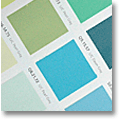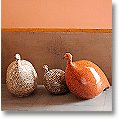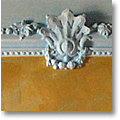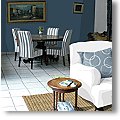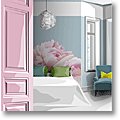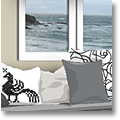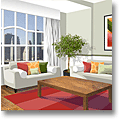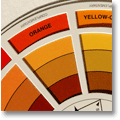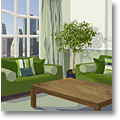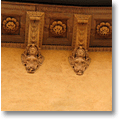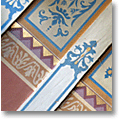Interior Design Colors 101:
How To Develop Interior Paint Ideas
And Decorating Color Schemes
Build interior design colors from scratch, in any room.
- Wondering how to pick the right wall colors? The article about Choosing Paint Color may be right for you.
- Looking for color scheme examples? Visit the pages about Great Color Combinations or Room Color Schemes, for more choice!
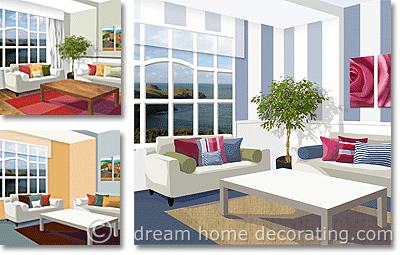
This page details the logical, step-by-step process of developing
room color schemes 'from the bottom up'.
Interior Design Colors, Step 1:
Color Inventory
1. Aspect/Orientation:
Does this room get a lot of sunlight? Or does it feel dark/cool/chilly, and in need of
warming interior
design colors and materials?
2. Which colors are in the room right now?
This
includes the view from the window, as well as the colors you see immediately before
entering the room, e.g. the hallway/door.
(Click
here for a list of areas/items to consider!)
- Which of the room colors can not be changed? => These will automatically become part of the interior design color scheme of this room.
- Do any of these colors suggest a color scheme for the room? (If you need some ideas to color a room, check out the articles on choosing interior paint colors and getting paint color ideas. There's also a list of tried-and-tested great color combinations to give you some ideas.)
- Are there any unwelcome or distracting colors that would need to be hidden/covered/overpainted? What is the most budget-friendly way of doing this?
Whether you're choosing interior design color schemes for yourself or for a client, your choices will be limited by the money available for this project.
Money no object? Proceed to Step 3!
Limited resources? Here's an example of what you could do:
Interior Design Colors, Step 2:
Clean Up Your Room Colors
Just as an example, let's assume you're looking for new colors for this living room:
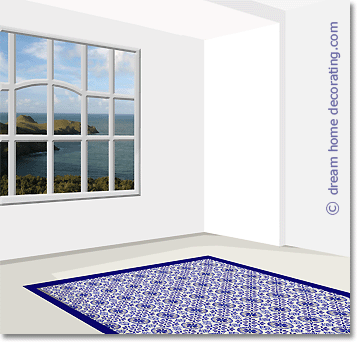
A cool, contemporary Mediterranean theme like this would be great in a sunbaked environment,
but for a northeast facing room in Western Europe ... it's not entirely convincing!
The painted concrete flooring with handpainted ceramic tiles in the middle, and the aluminum window have a distinctly icy feel. So we'll be looking for warmer, more comforting interior design colors and materials.
Replacing the window frame with a wooden one, putting down floorboards or installing wall-to-wall carpet is not cheap. So how could you 'neutralize' the current room color scheme and develop new interior color combinations without spending a fortune?
a) Window:
- Have the aluminum painted, or
- use window treatments that will - at least to some extent - conceal the metal frame. (This would also conceal the view!)
b) Flooring:
- Paint the concrete in your color of choice and cover the tiles with a rug.
Now you have a quasi-blank canvas
(the rug could be any color that fits into your final set of interior design colors):
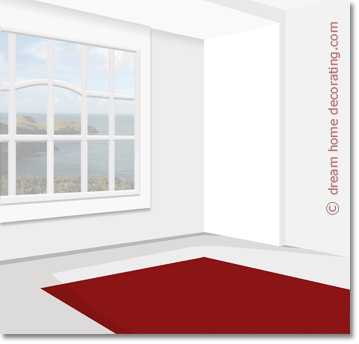
Interior Design Colors, Step 3:
How To Start Interior Color Combinations
Start building your color scheme around one or more items that are important to you, e.g.:
- Something you already have and are planning to use in this room (e.g. your sofa, rug, bed or curtains...)
- Something that was expensive to buy and that you don't want to change any time soon (e.g. a fine sofa, an exclusive rug, antique parquet flooring)
- Something that's hard to find and would be difficult to replace (e.g. handpainted wallpaper, an original painting)
Come what may, these items will be part of your set of interior design colors for this room. But all by themselves they may not provide you with exciting choices for great color combinations.
So for further color decorating ideas, look to ...
- The most conspicuous item (e.g. large-scale wall art, a fabulous rug, a textile in striking patterns, or accessories in great color combinations).
Again, an example:
We'll use these two Tuscan prints to inspire a color decorating theme for the room. The colors go well with the view from the window - similar greens and blues - but the painting also adds warmer room decorating colors through the underlying earth tone color scheme.
On the four-primary color wheel, the paintings represent opposing color groups: red/green and orange/turquoise:
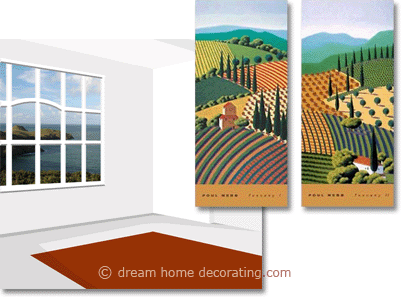
So in essence, we're going to create a red-green
complementary
color scheme, with a supporting cast of neutrals. Having settled on our interior design
colors, how are we going to distribute them in the room?
Here are just two (of many) great color combinations. The room to the left looks more soothing and welcoming, for three main reasons:
- Dark and light areas are more balanced through the mid-tone wall paint (the value contrast is quite stark in the room to the right => the room looks more austere as a result);
- The full curtains add a softness and texture to the window wall (left) that is missing in the right-hand room;
- The potted tree adds even more texture and a soothing natural hue to the interior design colors of the left room.
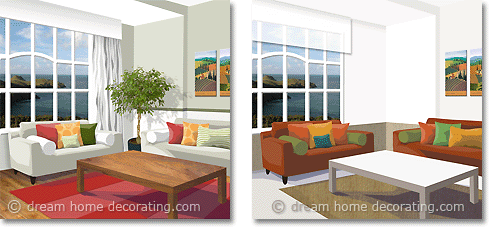
The 60-30-10 Rule
"60-30-10" is a rule of thumb for all kinds of color schemes. We're supposed to assign
- 60% to the 'dominant' color (e.g. the walls);
- 30% to a 'secondary' color (e.g. furniture/upholstery), and
- 10% are reserved for color accents
Looking at the two rooms above, you can see that the 60-30-10 color ratio sort of applies, but that it has nothing to do with color dominance. In the right picture, the walls are mostly a neutral white, but it's the red and orange colors that actually dominate the room. The red dominates even more in the left picture; the sage green upper walls are almost necessary to 'cool down' the impact of the rug.
In other words, the 60-30-10 'rule' is nice to keep in mind, but much more importantly, you want to pay attention to how colors interact in interior design color schemes.
By the way, you can apply the 60-30-10 rule to the color values as well:
60% light colors,
30% mid-tones and
10% dark
colors
is a good rule of thumb - and as before, I'd say apply with a healthy dose of anarchy!
Interior Design Colors, Step 4:
A Commonsense Decorating Color Scheme
Let's assume you like experimenting & updating your home decorating color schemes every so often. Unless you plan to replace your more expensive items (e.g. couch/upholstery, cupboards, cabinets) along with your wall color combinations, you'll need decorating staples that will easily play along with your color experiments.
In which case neutral colors
are your secret weapon. (Check out my
free e-book about neutral
color palettes!)
Why buy big-ticket items in Neutrals?
Because they
- won't go out of fashion by next spring,
- adapt easily to new color palettes and accessories
- seamlessly blend in with more up-to-the-minute decorating ideas.
Classics in neutrals are likely to stay with you for a long time - longer than your current wall color combinations, window treatments, or wall art. Having some timeless, quality furniture in neutral colors allows you to change all the low-cost items around it - thus creating a new room color mood - whenever you feel like a change of scene.
So let's base our next set of interior design colors around two sofas in a perfectly neutral, warm gray:
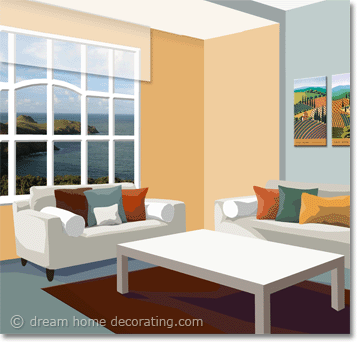
Even though the room decor is quite sparse, the apricot wall color and the earth color scheme of the sofa cushions give the little alcove an inviting warmth. On the other hand, if the room were exposed to intense sunlight, you may want to opt for a cooler color palette:
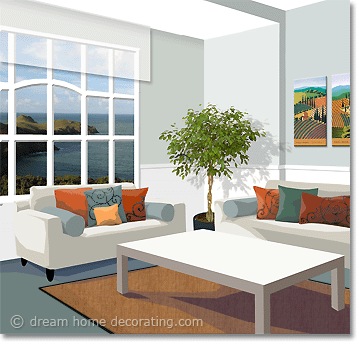
Same sofas, same basic color combination, but by giving the 60% share to neutral colors, you
have created a much calmer, cooler room color mood.
Next, let's say you've had the Tuscan color palette for a few seasons, and you'd like to update to a fresh 'New England summer' look, inspired by roses, ripe berries, and walks on the beach:
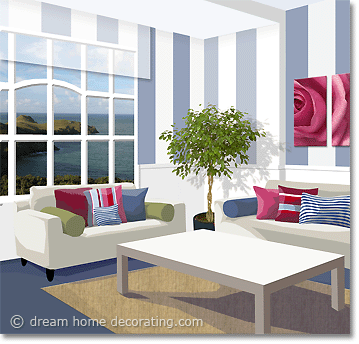
What we changed:
- the wall art,
- the interior wall colors (above the chair rail),
- the cushion covers,
- the floor paint color, and
- we brought in a fresh straw rug.
For about $200, the room's as good as new!
Interior Design Colors, Step 5:
Choosing Wall Colors Last
Why leave choosing interior paint colors until last?
- Because it's easier to find wall color combinations that go with your decorating textiles and your furniture, than the other way round. There simply are more colors to paint a room, than fabrics to dress a window, or carpets, or decorating accessories.
- Because changing interior wall colors is comparatively inexpensive. If your first paint color ideas don't look right, you can always repaint. No big deal.
Interior paint color combinations sometimes look great on small color swatches, but very disappointing once they're on your walls. Choosing paint color slowly and deliberately is really important. Always test your interior design colors thoroughly in different areas of the room and under different lighting conditions!
- Getting Color Ideas:
Choosing Interior Paint Colors
Paint Color Ideas
More Decorating Color Scheme Ideas
Great Color Combinations
- Mediterranean Interior Design Colors:
Tuscan Colors
French Country Colors
French Country Decor & Color on a Shoestring
Provence Interiors & Colors
- "Learning" Color:
Basic questions about Decorating Color Schemes
Color Psychology
How to develop Color Confidence
Understanding the Color Wheel Chart
Basic Color Wheel: How to Use It
Guide to the Primary Color Wheel
Warm And Cool Colors
Monochromatic Color Schemes
What Colors Mean
- Neutral Color Schemes - The
Book:
Neutral color palettes make great interior design colors, but they're not as straightforward as many people think. Understand what makes neutral color schemes look their best, and what happens when you mix neutral color palettes with more saturate interior design colors. It's FREE!!
Yet to find the information you're looking for? Type a word or phrase into the search box below:



